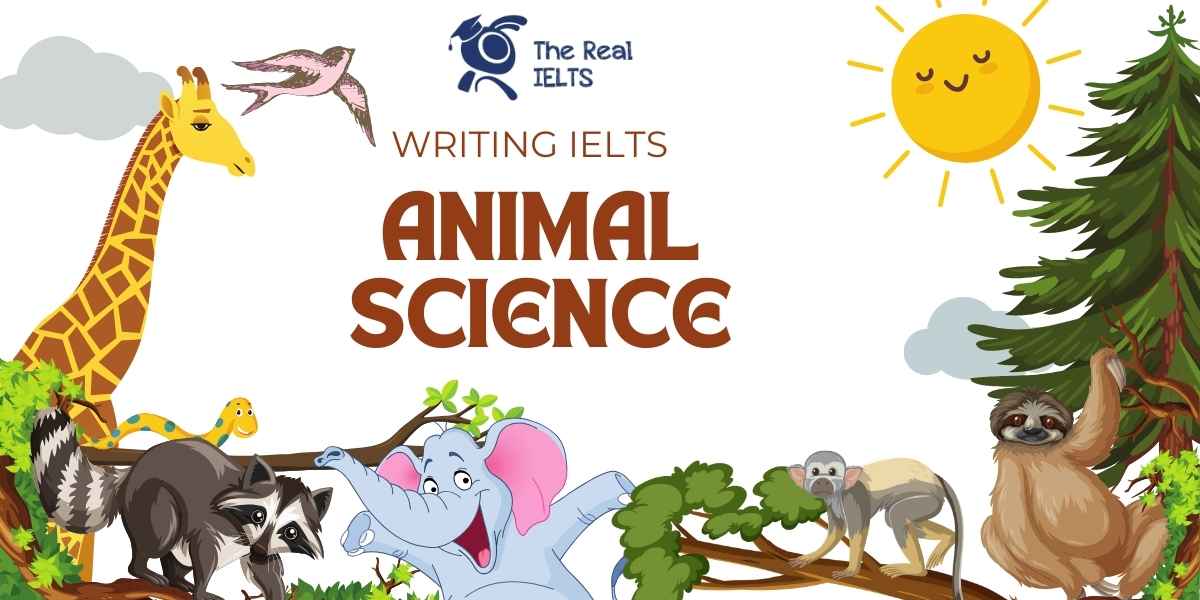Đây là bài viết luyện Writing IELTS. Chủ đề Animal cũng là chủ đề được đề cập nhiều ở các phần thi Reading, Listening, Writing và Speaking theo một cách bất kỳ.
Ngay bây giờ chúng ta sẽ đi vào chi tiết đề thi Writing:
Writing Climate Change
Climate change is a natural phenomenon, and there’s no need for humans to intervene in the process. To what extent do you agree or disagree?
Answer
| Agree | Disagree |
|---|---|
| Climate change has occurred throughout Earth’s history as a natural | Human activities, particularly the burning of fossil fuels, have |
| process, driven by various factors such as volcanic eruptions and | significantly accelerated the rate of climate change. This has led |
| fluctuations in solar radiation. | to unprecedented levels of greenhouse gas emissions, resulting in |
| global warming and climate disruptions at an alarming pace. | |
| Natural climate variations, such as the Milankovitch cycles, have | The current rate of climate change far exceeds natural variations, |
| played significant roles in shaping Earth’s climate over millions of | indicating a clear human influence on the climate system. |
| years. | |
| Climate models consistently demonstrate that human activities | |
| contribute substantially to observed climate trends, providing | |
| compelling evidence that intervention is necessary to mitigate | |
| further environmental damage. |
Conclusion: While it’s true that climate change has been a natural phenomenon throughout Earth’s history, the rapid and unprecedented changes we are witnessing today cannot solely be attributed to natural causes. Human activities, particularly the burning of fossil fuels, have significantly exacerbated the rate of climate change. The consensus among scientists is that intervention is necessary to mitigate the adverse effects of human-induced climate change.
Forest Fires
Forest fires have been occurring for centuries, and there’s no justification for humans to intervene in their natural cycle.
Answer
| Agree | Disagree |
|---|---|
| Forest fires are a natural part of many ecosystems, playing a crucial role in nutrient recycling and regeneration of certain plant species. They help maintain biodiversity and prevent the dominance of certain species. | While forest fires have been a natural occurrence for centuries, human intervention in forests and landscapes has significantly altered their frequency, intensity, and impact. Factors such as climate change, land management practices, and human encroachment have exacerbated the occurrence and severity of wildfires. |
| Interventions aimed at suppressing wildfires can disrupt natural processes, leading to the accumulation of fuel loads and increased fire severity in the long run. Allowing fires to burn under controlled conditions can help mitigate these risks and promote ecosystem resilience. | Uncontrolled wildfires pose significant risks to human lives, property, and infrastructure. Interventions such as firefighting efforts, prescribed burns, and forest management strategies are necessary to protect communities and mitigate the negative impacts of wildfires. |
| Indigenous land management practices, such as controlled burns, have been used for centuries to maintain healthy ecosystems and reduce the risk of catastrophic wildfires. These traditional approaches can serve as valuable tools in modern wildfire management efforts. | Neglecting to intervene in wildfires can result in devastating consequences, including loss of human life, destruction of habitats, and long-term environmental damage. Effective intervention strategies are essential for protecting both natural ecosystems and human communities. |
| Human development in wildfire-prone areas increases the likelihood of ignition sources, such as power lines, campfires, and discarded cigarettes. Implementing strict regulations and land-use planning can help minimize the human impact on fire-prone landscapes and reduce the need for intervention. | While some level of intervention may be necessary to protect lives and property, it’s crucial to prioritize proactive measures such as wildfire prevention, education, and community preparedness to reduce the reliance on reactive firefighting efforts. |
Conclusion: While acknowledging the natural role of forest fires, it’s apparent that the human impact on landscapes has significantly altered the dynamics of wildfires. While there are valid arguments for allowing fires to burn under controlled conditions and utilizing traditional land management practices, there’s also a need for intervention to protect human lives, property, and ecosystems from the increasing risks posed by uncontrolled wildfires exacerbated by human activities. Finding a balance between allowing natural processes to occur and implementing effective intervention strategies is essential for promoting both ecological health and community safety in fire-prone areas.
Evolutionary Adaptations
Evolutionary adaptations occur naturally, and there’s no need for human interference in the process. To what extent do you agree or disagree?
Answer
| Agree | Disagree |
|---|---|
| 1. Natural Selection: Evolutionary adaptations primarily occur through natural selection, where organisms with advantageous traits are more likely to survive and reproduce, passing on those traits to future generations. This process operates without human interference. | 1. Human Impact: Human activities such as habitat destruction, pollution, and climate change can disrupt natural selection pressures, leading to maladaptation or extinction of species. Therefore, some argue that human intervention may be necessary to mitigate these impacts and assist in preserving biodiversity. |
| 2. Genetic Drift: Evolution can also occur through genetic drift, a random process that leads to changes in the frequency of certain alleles in a population. Genetic drift is a natural phenomenon that operates without human intervention. | 2. Artificial Selection: While natural selection occurs without human interference, humans have also utilized artificial selection for centuries to selectively breed plants and animals with desired traits. This intervention has significantly influenced the evolution of many species, such as domesticated crops and livestock. |
| 3. Adaptation: Organisms naturally adapt to their environments over time through mechanisms like physiological, behavioral, and morphological changes. These adaptations are driven by environmental pressures and occur without human intervention. | 3. Human-Assisted Evolution: In certain cases, human intervention has led to rapid evolutionary changes, such as the development of antibiotic resistance in bacteria due to overuse of antibiotics. This highlights how human activities can inadvertently drive evolutionary processes. |
Conclusion: While evolutionary adaptations predominantly occur naturally without human interference, human activities can also influence evolutionary processes through factors like habitat destruction, artificial selection, and the introduction of novel selection pressures. Thus, while natural selection remains the primary driver of evolution, human impact can alter its course, necessitating careful consideration of our role in ecological dynamics.
Natural Disasters
Natural disasters like earthquakes and hurricanes are part of Earth’s natural cycle, and there’s no reason for humans to prevent them. To what extent do you agree or disagree?
Answer
| Agree | Disagree |
|---|---|
| 1. Earth’s Natural Processes: Acknowledges that earthquakes and hurricanes are indeed part of Earth’s natural cycle, formed by geological and meteorological processes over millions of years. | 1. Human Vulnerability and Impact: Argues that while natural disasters are part of Earth’s natural cycle, their impacts on human lives, infrastructure, and economies are significant and devastating. |
| 2. Ecological Balance: Suggests that these events play a role in maintaining ecological balance by reshaping landscapes, distributing nutrients, and influencing biodiversity. | 2. Human Responsibility and Mitigation: Advocates for human intervention in preventing or mitigating the impacts of natural disasters through early warning systems, infrastructure development, and disaster preparedness measures. |
| 3. Adaptation and Resilience: Emphasizes the importance of communities and ecosystems adapting and building resilience to withstand natural disasters, utilizing techniques such as sustainable land-use planning and ecosystem restoration. | 3. Climate Change Amplification: Points out that human activities, particularly related to climate change, can exacerbate the frequency and intensity of natural disasters, making prevention and mitigation efforts crucial for safeguarding human lives and the environment. |
Conclusion: While it is true that earthquakes and hurricanes are inherent parts of Earth’s natural cycle, the disagreement column highlights the necessity for human intervention in addressing their impacts. Human vulnerability, responsibility, and the amplification of these disasters due to climate change underline the importance of proactive measures to prevent, mitigate, and adapt to such events, rather than passively accepting them as unavoidable occurrences.
Ecosystem Changes
Changes in ecosystems are a natural occurrence, and humans should not interfere with these natural processes. To what extent do you agree or disagree?
| Agree | Disagree |
|---|---|
| 1. Ecosystems have evolved over millions of years through natural processes, and interference by humans can disrupt delicate balances. | 1. Human activities, such as deforestation, pollution, and habitat destruction, have significantly altered ecosystems, leading to loss of biodiversity and ecological imbalance. |
| 2. Allowing natural processes to unfold without interference can sometimes lead to greater resilience and adaptability within ecosystems. | 2. Humans have a responsibility to steward and protect the environment, as our actions can have far-reaching consequences for the health of ecosystems and the well-being of future generations. |
| 3. Intervening in natural processes can sometimes have unintended consequences, such as the introduction of invasive species or disruption of food chains. | 3. Conservation efforts, including habitat restoration, species reintroduction, and sustainable resource management, can help mitigate the negative impacts of human activity and preserve biodiversity. |
| 4. Nature has its own mechanisms for resilience and recovery, and humans may not always fully understand the complexities of ecosystems to effectively intervene. | 4. Climate change, driven largely by human activity, is causing rapid shifts in ecosystems that may outpace the ability of natural processes to adapt, necessitating proactive intervention to mitigate the impacts. |
Conclusion:
While acknowledging the importance of natural processes in shaping ecosystems, the disagreement column highlights the necessity of human intervention to counteract the detrimental effects of human activities on the environment. It emphasizes the responsibility of humans to actively protect and conserve ecosystems through informed management practices and conservation efforts. Striking a balance between allowing natural processes to unfold and intervening to mitigate human-induced damage is essential for ensuring the health and sustainability of ecosystems.















